Industry News, trenchless products
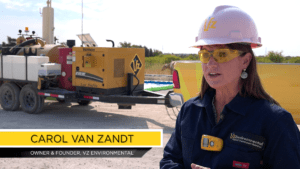 VZ Environmental is an innovative leader in secondary drip and spill containment for the oil and gas industry. Carol Van Zandt, owner of VZ Environmental, was challenged by a customer to find a simple method to contain liquid spills in the oil and gas industry. Carol partnered with an equipment supplier to design a drive-over foam bermed containment membrane (VMatz™) to capture and dispose of drips and spills on oil and gas sites. They then utilize a Vac-Tron vacuum excavator to clean up the spill from the containment membrane for proper disposal.
VZ Environmental is an innovative leader in secondary drip and spill containment for the oil and gas industry. Carol Van Zandt, owner of VZ Environmental, was challenged by a customer to find a simple method to contain liquid spills in the oil and gas industry. Carol partnered with an equipment supplier to design a drive-over foam bermed containment membrane (VMatz™) to capture and dispose of drips and spills on oil and gas sites. They then utilize a Vac-Tron vacuum excavator to clean up the spill from the containment membrane for proper disposal.
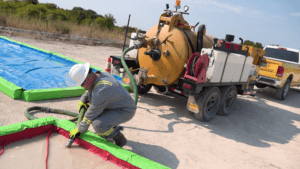 Today, VZ Environmental provides equipment nationwide, servicing areas in five states and have plans for further domestic and international expansion to continue to help oil and gas operators minimize their impact on the environment.
Today, VZ Environmental provides equipment nationwide, servicing areas in five states and have plans for further domestic and international expansion to continue to help oil and gas operators minimize their impact on the environment.
Project Descriptions
VMatz are spill containments that VZ provides for oil and gas operators to minimize their impact on the environment. “Our customers use the VMatz to catch drips and spills while on location and then we come in to cleanup,” says Carol. VZ wanted to provide their own vacuum service to their customers as part of the cleanup process, so that the customer didn’t have to waste time and money calling out for a vacuum truck company and VZ environmental didn’t have to sit on location and wait for the vacuum truck to arrive before they could cleanup.
Solution
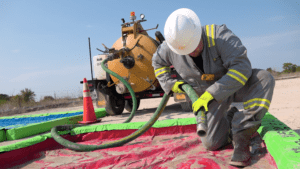 Vac-Tron vacuum trailers for vacuum service and cleanup. “The Vac-Tron trailer helps us clean up our VMAtz by removing the fluid from our containments more efficiently and a lot faster. We are not sitting on location waiting on vacuum trucks to arrive. Prior to having Vac-Tron vacuum trailers in our fleet of equipment, we did not offer any type of vacuum service. Our customers had to order a vacuum truck to come help us remove the fluid when we were cleaning our Vmatz. Our Vac-Tron units come with 500-gallon debris tanks and 1,000 cfm which helps us pick up the rocks and sludge that our customers leave in our containments. This is a perfect size because its small and they can park it off to the side, then call upon it as needed,” says Carol.
Vac-Tron vacuum trailers for vacuum service and cleanup. “The Vac-Tron trailer helps us clean up our VMAtz by removing the fluid from our containments more efficiently and a lot faster. We are not sitting on location waiting on vacuum trucks to arrive. Prior to having Vac-Tron vacuum trailers in our fleet of equipment, we did not offer any type of vacuum service. Our customers had to order a vacuum truck to come help us remove the fluid when we were cleaning our Vmatz. Our Vac-Tron units come with 500-gallon debris tanks and 1,000 cfm which helps us pick up the rocks and sludge that our customers leave in our containments. This is a perfect size because its small and they can park it off to the side, then call upon it as needed,” says Carol.
Results
- Saves customers time and money
- Eliminates down time
- Keeps environment safer
“With a Vac-Tron trailer, we can save our customers money through minimizing the number of trips that they have to call out a vacuum truck. When shopping for vacuum trailers, Vac-Tron is by far the best! Our machines, every time you turn them on, they are rip roaring to go. Our employees don’t have time to go through and try to figure out things, they want to flip it on and use it immediately and they want it to work. Vac-Tron does that for us every time,” says Carol.
Check out the full video interview with VZ Environmental here. For more information on Vac-Tron Equipment and its full fleet of vacuum excavators, please visit them online at www.vactron.com or call 1-352-728-2222.
Industry News, trenchless products
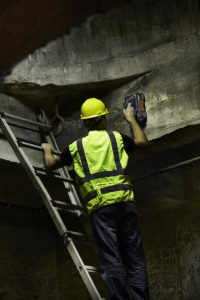 GSSI, the world’s leading manufacturer of ground penetrating radar (GPR) equipment, announces the addition of a new drill hole feature to the StructureScan™ Mini XT – the newest generation of GSSI’s popular all-in-one concrete inspection GPR system. The drill hole feature is a 3D data processing detection algorithm. The algorithm evaluates a user chosen cylindrical area that represents a potential or planned coring location. Scanning for all potential targets within the cylindrical area, the drill hole feature looks for targets that may interfere with a proposed coring location.
GSSI, the world’s leading manufacturer of ground penetrating radar (GPR) equipment, announces the addition of a new drill hole feature to the StructureScan™ Mini XT – the newest generation of GSSI’s popular all-in-one concrete inspection GPR system. The drill hole feature is a 3D data processing detection algorithm. The algorithm evaluates a user chosen cylindrical area that represents a potential or planned coring location. Scanning for all potential targets within the cylindrical area, the drill hole feature looks for targets that may interfere with a proposed coring location.
Available only within the StructureScan Mini XT user interface, the drill hole indicator is designed for concrete coring applications. In complicated slab situations, the drill hole feature can help users determine the safest location for coring concrete. However, this feature is not a substitute for careful analysis by a trained operator, and GSSI does not recommend that the user depend solely on this algorithm for drill hole interpretation.
Operators should receive special training prior to using this new aid. During training, customers can select areas that they believe are safe for coring while the feature is turned off, and turn the feature on to double check and confirm the initial mark outs.
The new drill hole feature will work with all StructureScan Mini XT’s already in the field, and only requires a software update of the system. New units will come with this user interface pre-installed.
About GSSI
Geophysical Survey Systems, Inc. is the world leader in the development, manufacture, and sale of ground penetrating radar (GPR) equipment, primarily for the concrete inspection, utility mapping and locating, road and bridge deck evaluation, geophysics, and archaeology markets. Our equipment is used all over the world to explore the subsurface of the earth and to inspect infrastructure systems non-destructively. GSSI created the first commercial GPR system nearly 50 years ago and continues to provide the widest range and highest quality GPR equipment available today.
Industry News, trenchless products, trenchless projects
Massive XRE Machine breaks through at Akron OCIT
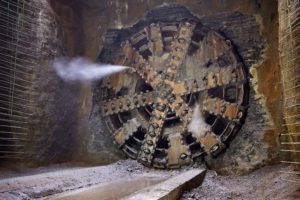 On August 29, 2018, a 9.26 m (30.4 ft) diameter Robbins Crossover (XRE) TBM crossed the finish line at the Akron Ohio Canal Interceptor Tunnel (OCIT). A press day followed on September 5, where companies and members of the media were invited to view the giant machine. The machine—dubbed “Rosie” in honor of Rosie the Riveter, an icon representing American women who worked in factories and shipyards during World War II—overcame tough ground conditions during the bore.
On August 29, 2018, a 9.26 m (30.4 ft) diameter Robbins Crossover (XRE) TBM crossed the finish line at the Akron Ohio Canal Interceptor Tunnel (OCIT). A press day followed on September 5, where companies and members of the media were invited to view the giant machine. The machine—dubbed “Rosie” in honor of Rosie the Riveter, an icon representing American women who worked in factories and shipyards during World War II—overcame tough ground conditions during the bore.
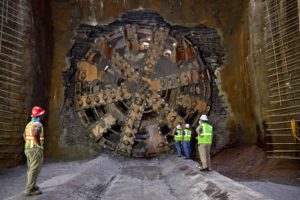 “One of the most challenging aspects of this job was that we launched right into the most difficult part. We had 60 m (200 ft) of soft ground, a very short reach, and then from there we went right into a mixed face for 180 m (600 ft),” said David Chastka, Project Manager for Kenny Construction, a joint venture contractor on the project with Obayashi. “It took everybody we had in the industry, everybody from Robbins, to fight through that first 240 m (800 ft).”
“One of the most challenging aspects of this job was that we launched right into the most difficult part. We had 60 m (200 ft) of soft ground, a very short reach, and then from there we went right into a mixed face for 180 m (600 ft),” said David Chastka, Project Manager for Kenny Construction, a joint venture contractor on the project with Obayashi. “It took everybody we had in the industry, everybody from Robbins, to fight through that first 240 m (800 ft).”
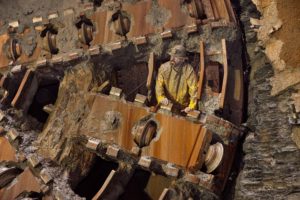 The TBM was designed for the project’s geology, which transitioned from soil to partial face shale to full face shale rock. The Crossover XRE included features of both EPB and Hard Rock Single Shield TBM types, with a versatile cutterhead that could be configured for hard rock or soft ground conditions. While in soft ground and mixed face conditions the machine operated in closed mode, but once it hit solid rock crews switched excavation to open mode. “The machine had the power to get to the other side and made advance rates we never thought we were going to get. It was very successful in hard rock,” said Chastka. Advance rates once in full-face shale rock reached a high of 34 m (111 ft) in one day (two 10-hour shifts). Muck removal was achieved using a Robbins continuous conveyor, and conveyor availability remained high throughout the project.
The TBM was designed for the project’s geology, which transitioned from soil to partial face shale to full face shale rock. The Crossover XRE included features of both EPB and Hard Rock Single Shield TBM types, with a versatile cutterhead that could be configured for hard rock or soft ground conditions. While in soft ground and mixed face conditions the machine operated in closed mode, but once it hit solid rock crews switched excavation to open mode. “The machine had the power to get to the other side and made advance rates we never thought we were going to get. It was very successful in hard rock,” said Chastka. Advance rates once in full-face shale rock reached a high of 34 m (111 ft) in one day (two 10-hour shifts). Muck removal was achieved using a Robbins continuous conveyor, and conveyor availability remained high throughout the project.
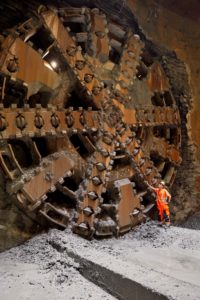 “I am most proud of the team that I have had the pleasure of being a part of,” said Don Smida, Robbins Field Service Technician. The overall scope of a project of this scale is immense, and the amount of daily cooperation & hard work that has been asked of The Robbins Company, the local unions, city staff, and Kenny-Obayashi is extremely important in reaching our common goals. I think we should all be proud of our teamwork going forward from a successful completion of the tunnel and into a successful disassembly of Rosie.”
“I am most proud of the team that I have had the pleasure of being a part of,” said Don Smida, Robbins Field Service Technician. The overall scope of a project of this scale is immense, and the amount of daily cooperation & hard work that has been asked of The Robbins Company, the local unions, city staff, and Kenny-Obayashi is extremely important in reaching our common goals. I think we should all be proud of our teamwork going forward from a successful completion of the tunnel and into a successful disassembly of Rosie.”
Now that tunneling is complete, the machine will be disassembled and removed from its retrieval shaft this autumn. “The Ohio Canal Interceptor Tunnel is the largest public improvement project in our City’s history and a significant investment in our environment and infrastructure that will benefit Akron residents and businesses for generations to come,” said the City of Akron’s Mayor Daniel Horrigan. “Projects of this kind are inherently dangerous, and I am incredibly proud that the tunneling portion was completed without any major injuries, thanks to a dedicated team of professionals. And although Robbins is an international company with worldwide impact, we were pleased to be able to work with a local Northeast Ohio firm on this significant project.”
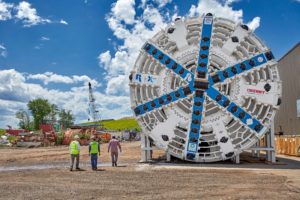 The OCIT Project for the City of Akron, Ohio, USA consists of the construction of a conveyance and storage tunnel system to control Combined Sewer Overflows (CSOs) for several regulators in the downtown Akron area. The EPA-mandated project includes the 1.89 km (1.17 mi) conveyance and storage tunnel, as well as drop shafts, diversion structures, consolidation sewers, and related structures.
The OCIT Project for the City of Akron, Ohio, USA consists of the construction of a conveyance and storage tunnel system to control Combined Sewer Overflows (CSOs) for several regulators in the downtown Akron area. The EPA-mandated project includes the 1.89 km (1.17 mi) conveyance and storage tunnel, as well as drop shafts, diversion structures, consolidation sewers, and related structures.
Image 1: On August 29, 2018, a 9.26 m (30.4 ft) diameter Robbins Crossover TBM broke through at the Akron Ohio Canal Interceptor Tunnel (OCIT).
Image 2: Personnel inspect the Robbins Crossover XRE TBM “Rosie”, named for Rosie the Riveter, after the breakthrough.
Image 3: A crew member cleans the cutterhead of the Robbins Crossover TBM following its breakthrough on August 29, 2018.
Image 4: The Robbins Crossover XRE machine—the first such machine to operate in the U.S.—achieved advance rates of up to 34 m (111 ft) per day in two 10-hour shifts.
Image 5: The 9.26 m (30.4 ft) diameter Robbins Crossover TBM was designed and built in Robbins’ Solon, Ohio, USA facility.
Industry News, trenchless products
 Project: C470 Managed Lanes
Project: C470 Managed Lanes
Owner: CDOT
General Contractor: Flatiron / AECOM Joint Venture
Tunneling Subcontractor: BTrenchless (A Division of BT Construction, Inc.)
BTrenchless is the tunneling subcontractor for Flatiron/AECOM Joint Venture for the expansion of the C470 corridor on the South side of the Denver Metro area.
BTrenchless has completed the following drives on this project:
- 362 LF of 42” RCP was installed using the Akkerman 420 Tunnel Boring Machine.
- 324 LF of 48” RCP was installed using the Akkerman 480 Tunnel Boring Machine.
- 387 LF of 72” RCP was installed using the Akkerman 720 Tunnel Boring Machine.
- 355 LF of 72” RCP. This storm sewer line is in a redesign phase and will be installed using the Akkerman 720 Tunnel Boring Machine.
- 267 LF of 66” RCP. This tunnel is in the final design phase and will be installed using the Akkerman 660 Tunnel Boring Machine.
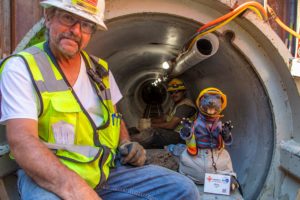 The main challenges encountered during this project were an abandoned 48” steel waterline and an abandoned 12” AC waterline that were found during our 72” RCP tunnel drive. We first encountered the 48” steel waterline and had to remove a section of the waterline through the head of the 720 TBM, as we continued the drive another 30 LF, we encountered a 12” AC waterline that had to be abated and removed through the head of the 720 TBM, as well.
The main challenges encountered during this project were an abandoned 48” steel waterline and an abandoned 12” AC waterline that were found during our 72” RCP tunnel drive. We first encountered the 48” steel waterline and had to remove a section of the waterline through the head of the 720 TBM, as we continued the drive another 30 LF, we encountered a 12” AC waterline that had to be abated and removed through the head of the 720 TBM, as well.
Overall, this tunneling project has been a success for all parties involved, despite the challenges that we have encountered.
As always, Morty the Tunnel Rat is on hand to supervise the project!
Industry News, trenchless people, trenchless products
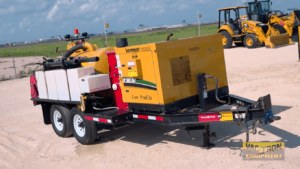 A strong dealer support network combined with a safe and reliable product are yielding satisfied customers and increased revenue for Texas First Rentals, sister company to Holt Cat®, one of the Largest Caterpillar Dealers in the US. At Texas First, you can rent the Cat® equipment you’ve always trusted for your toughest jobs – plus a whole lot more: equipment from Genie®, JLG®, Sullair®, Wacker®, LayMor®, Vermeer®, and other top-notch manufacturers including Vac-Tron Equipment.
A strong dealer support network combined with a safe and reliable product are yielding satisfied customers and increased revenue for Texas First Rentals, sister company to Holt Cat®, one of the Largest Caterpillar Dealers in the US. At Texas First, you can rent the Cat® equipment you’ve always trusted for your toughest jobs – plus a whole lot more: equipment from Genie®, JLG®, Sullair®, Wacker®, LayMor®, Vermeer®, and other top-notch manufacturers including Vac-Tron Equipment.
Project Challenge
Finding the perfect vacuum excavator and industrial vacuum equipment to add to the rental fleet. “The most important factors in determining what fleet we bought was the relationship we have with our dealer support network and the fact that we can utilize one model and maintain a commonality of parts.” said Colin Martin, District Manager of Texas First.
Solution
Vac-Tron Equipment vacuum excavators and industrial vacs. “We started buying the Vac-Tron machine when we initially started the company back in 2015. It’s a product that appears across all our stores, we have about 15 stores across the state of Texas,” said Martin. Michael Rutledge, Outside Sales Rep added, “The best advantage for us to be carrying Vac-Tron is our competitors don’t, so we have the upper edge. So, for an outside sales rep, its an absolute gold winner. The hydro vac makes it simpler and safer to use than the conventional excavator.”
Results
Satisfied customers and satisfied company owners. “I hear probably weekly that our customers are very satisfied with the product. At this current location, there are three customers that currently use these Vac-Tron’s monthly, some even use them long term on a 3-6-month basis” says Rutledge. “I would recommend these machines to others just for the ease of use, ease of maintenance, service ability concerns, and the return on investment” says Martin. “The rental return on investment (ROI) is how we are opening our doors everyday and closing them at the end of the day. I think this product is really making that bottom line more effective” added Rutledge.
Check out the full video interview with Texas First Rentals here. For more information on Vac-Tron Equipment and its full fleet of vacuum excavators, please visit them online at www.vactron.com or call 1-352-728-2222.
Industry News, trenchless products
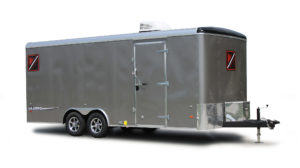 LAKE MILLS, Wisc. – HammerHead® Trenchless, a Charles Machine Works company, has introduced a new, purpose-built trailer for cured-in-place-pipe (CIPP) applications that gives installers a uniquely versatile and efficient workstation suited to almost any job they encounter. The LT-20PRO features a modular design with all storage, electrical power and air supply needed for a wide range of lateral lining tasks. The configuration is customizable, allowing the customer to tailor it to their specific needs and avoid duplication of existing equipment.
LAKE MILLS, Wisc. – HammerHead® Trenchless, a Charles Machine Works company, has introduced a new, purpose-built trailer for cured-in-place-pipe (CIPP) applications that gives installers a uniquely versatile and efficient workstation suited to almost any job they encounter. The LT-20PRO features a modular design with all storage, electrical power and air supply needed for a wide range of lateral lining tasks. The configuration is customizable, allowing the customer to tailor it to their specific needs and avoid duplication of existing equipment.
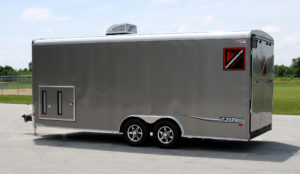 The 20-foot-long trailer’s modular design not only maintains an efficient workspace during installations but keeps all components secure and at-the-ready while traveling from job to job.
The 20-foot-long trailer’s modular design not only maintains an efficient workspace during installations but keeps all components secure and at-the-ready while traveling from job to job.
On more restrictive job sites, all equipment in the LT-20PRO can be unmounted for easy relocation. “Our trailer’s modular design accommodates the widest range of environments, difficult site conditions and logistics,” said Matt Gabrielse, HammerHead product manager.
“Versatility was key in creating these trailers for our customers,” Gabrielse said, explaining that ideally all jobs could be completed from right inside a contractor’s trailer. “But in cases where it is necessary to work from a roof or inside a large building, our rig allows key components to be easily removed from the trailer to work remotely.”
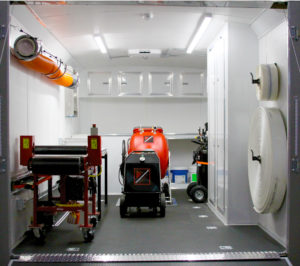 Each trailer can be outfitted with the desired inversion drum size, curing equipment, reinstatement and drain cleaning tools to meet each customer’s individual needs.
Each trailer can be outfitted with the desired inversion drum size, curing equipment, reinstatement and drain cleaning tools to meet each customer’s individual needs.
HammerHead LT-20PRO CIPP trailers are also available ready-made for immediate sale and delivery. All LT-20PRO base models feature as standard
- Insulated trailer walls and ceiling and a roof-mounted air conditioner
- 13,000-watt generator with external slide-out
- Roller bed with wall mount for the wet out table
- 30-gallon, wall-mounted air compressor
- External and internal air connections and electrical outlets
- Unique new HammerHead liner vacuum system for ease in vacuum-prepping liner.
The trailer’s modular configuration optimizes use of space and leaves ample room for storage. Storage features include
- Upper and lower storage cabinets
- Lower resin storage cabinet
- Cleaning supply cabinet
- Tool boxes
- A tongue-mounted, lockable storage box
- Custom inversion hose rack
- Wall hooks to hold liner and calibration tubes.
The LT-20PRO purpose-built lateral lining trailer is available direct from HammerHead Trenchless in the United States and Canada. Find your HammerHead sales representative at www.hammerheadtrenchless.com or by calling 920.648.4848.
Photos: The LT-20PRO purpose-built lateral lining trailer is available direct from HammerHead Trenchless in the United States and Canada.
 VZ Environmental is an innovative leader in secondary drip and spill containment for the oil and gas industry. Carol Van Zandt, owner of VZ Environmental, was challenged by a customer to find a simple method to contain liquid spills in the oil and gas industry. Carol partnered with an equipment supplier to design a drive-over foam bermed containment membrane (VMatz™) to capture and dispose of drips and spills on oil and gas sites. They then utilize a Vac-Tron vacuum excavator to clean up the spill from the containment membrane for proper disposal.
VZ Environmental is an innovative leader in secondary drip and spill containment for the oil and gas industry. Carol Van Zandt, owner of VZ Environmental, was challenged by a customer to find a simple method to contain liquid spills in the oil and gas industry. Carol partnered with an equipment supplier to design a drive-over foam bermed containment membrane (VMatz™) to capture and dispose of drips and spills on oil and gas sites. They then utilize a Vac-Tron vacuum excavator to clean up the spill from the containment membrane for proper disposal. Today, VZ Environmental provides equipment nationwide, servicing areas in five states and have plans for further domestic and international expansion to continue to help oil and gas operators minimize their impact on the environment.
Today, VZ Environmental provides equipment nationwide, servicing areas in five states and have plans for further domestic and international expansion to continue to help oil and gas operators minimize their impact on the environment. Vac-Tron vacuum trailers for vacuum service and cleanup. “The Vac-Tron trailer helps us clean up our VMAtz by removing the fluid from our containments more efficiently and a lot faster. We are not sitting on location waiting on vacuum trucks to arrive. Prior to having Vac-Tron vacuum trailers in our fleet of equipment, we did not offer any type of vacuum service. Our customers had to order a vacuum truck to come help us remove the fluid when we were cleaning our Vmatz. Our Vac-Tron units come with 500-gallon debris tanks and 1,000 cfm which helps us pick up the rocks and sludge that our customers leave in our containments. This is a perfect size because its small and they can park it off to the side, then call upon it as needed,” says Carol.
Vac-Tron vacuum trailers for vacuum service and cleanup. “The Vac-Tron trailer helps us clean up our VMAtz by removing the fluid from our containments more efficiently and a lot faster. We are not sitting on location waiting on vacuum trucks to arrive. Prior to having Vac-Tron vacuum trailers in our fleet of equipment, we did not offer any type of vacuum service. Our customers had to order a vacuum truck to come help us remove the fluid when we were cleaning our Vmatz. Our Vac-Tron units come with 500-gallon debris tanks and 1,000 cfm which helps us pick up the rocks and sludge that our customers leave in our containments. This is a perfect size because its small and they can park it off to the side, then call upon it as needed,” says Carol.
 GSSI
GSSI On August 29, 2018, a 9.26 m (30.4 ft) diameter Robbins Crossover (XRE) TBM crossed the finish line at the Akron Ohio Canal Interceptor Tunnel (OCIT). A press day followed on September 5, where companies and members of the media were invited to view the giant machine. The machine—dubbed “Rosie” in honor of Rosie the Riveter, an icon representing American women who worked in factories and shipyards during World War II—overcame tough ground conditions during the bore.
On August 29, 2018, a 9.26 m (30.4 ft) diameter Robbins Crossover (XRE) TBM crossed the finish line at the Akron Ohio Canal Interceptor Tunnel (OCIT). A press day followed on September 5, where companies and members of the media were invited to view the giant machine. The machine—dubbed “Rosie” in honor of Rosie the Riveter, an icon representing American women who worked in factories and shipyards during World War II—overcame tough ground conditions during the bore. “One of the most challenging aspects of this job was that we launched right into the most difficult part. We had 60 m (200 ft) of soft ground, a very short reach, and then from there we went right into a mixed face for 180 m (600 ft),” said David Chastka, Project Manager for Kenny Construction, a joint venture contractor on the project with Obayashi. “It took everybody we had in the industry, everybody from Robbins, to fight through that first 240 m (800 ft).”
“One of the most challenging aspects of this job was that we launched right into the most difficult part. We had 60 m (200 ft) of soft ground, a very short reach, and then from there we went right into a mixed face for 180 m (600 ft),” said David Chastka, Project Manager for Kenny Construction, a joint venture contractor on the project with Obayashi. “It took everybody we had in the industry, everybody from Robbins, to fight through that first 240 m (800 ft).” The TBM was designed for the project’s geology, which transitioned from soil to partial face shale to full face shale rock. The Crossover XRE included features of both EPB and Hard Rock Single Shield TBM types, with a versatile cutterhead that could be configured for hard rock or soft ground conditions. While in soft ground and mixed face conditions the machine operated in closed mode, but once it hit solid rock crews switched excavation to open mode. “The machine had the power to get to the other side and made advance rates we never thought we were going to get. It was very successful in hard rock,” said Chastka. Advance rates once in full-face shale rock reached a high of 34 m (111 ft) in one day (two 10-hour shifts). Muck removal was achieved using a Robbins continuous conveyor, and conveyor availability remained high throughout the project.
The TBM was designed for the project’s geology, which transitioned from soil to partial face shale to full face shale rock. The Crossover XRE included features of both EPB and Hard Rock Single Shield TBM types, with a versatile cutterhead that could be configured for hard rock or soft ground conditions. While in soft ground and mixed face conditions the machine operated in closed mode, but once it hit solid rock crews switched excavation to open mode. “The machine had the power to get to the other side and made advance rates we never thought we were going to get. It was very successful in hard rock,” said Chastka. Advance rates once in full-face shale rock reached a high of 34 m (111 ft) in one day (two 10-hour shifts). Muck removal was achieved using a Robbins continuous conveyor, and conveyor availability remained high throughout the project. “I am most proud of the team that I have had the pleasure of being a part of,” said Don Smida, Robbins Field Service Technician. The overall scope of a project of this scale is immense, and the amount of daily cooperation & hard work that has been asked of The Robbins Company, the local unions, city staff, and Kenny-Obayashi is extremely important in reaching our common goals. I think we should all be proud of our teamwork going forward from a successful completion of the tunnel and into a successful disassembly of Rosie.”
“I am most proud of the team that I have had the pleasure of being a part of,” said Don Smida, Robbins Field Service Technician. The overall scope of a project of this scale is immense, and the amount of daily cooperation & hard work that has been asked of The Robbins Company, the local unions, city staff, and Kenny-Obayashi is extremely important in reaching our common goals. I think we should all be proud of our teamwork going forward from a successful completion of the tunnel and into a successful disassembly of Rosie.” The OCIT Project for the City of Akron, Ohio, USA consists of the construction of a conveyance and storage tunnel system to control Combined Sewer Overflows (CSOs) for several regulators in the downtown Akron area. The EPA-mandated project includes the 1.89 km (1.17 mi) conveyance and storage tunnel, as well as drop shafts, diversion structures, consolidation sewers, and related structures.
The OCIT Project for the City of Akron, Ohio, USA consists of the construction of a conveyance and storage tunnel system to control Combined Sewer Overflows (CSOs) for several regulators in the downtown Akron area. The EPA-mandated project includes the 1.89 km (1.17 mi) conveyance and storage tunnel, as well as drop shafts, diversion structures, consolidation sewers, and related structures. Project: C470 Managed Lanes
Project: C470 Managed Lanes The main challenges encountered during this project were an abandoned 48” steel waterline and an abandoned 12” AC waterline that were found during our 72” RCP tunnel drive. We first encountered the 48” steel waterline and had to remove a section of the waterline through the head of the 720 TBM, as we continued the drive another 30 LF, we encountered a 12” AC waterline that had to be abated and removed through the head of the 720 TBM, as well.
The main challenges encountered during this project were an abandoned 48” steel waterline and an abandoned 12” AC waterline that were found during our 72” RCP tunnel drive. We first encountered the 48” steel waterline and had to remove a section of the waterline through the head of the 720 TBM, as we continued the drive another 30 LF, we encountered a 12” AC waterline that had to be abated and removed through the head of the 720 TBM, as well. A strong dealer support network combined with a safe and reliable product are yielding satisfied customers and increased revenue for Texas First Rentals, sister company to Holt Cat®, one of the Largest Caterpillar Dealers in the US. At Texas First, you can rent the Cat® equipment you’ve always trusted for your toughest jobs – plus a whole lot more: equipment from Genie®, JLG®, Sullair®, Wacker®, LayMor®, Vermeer®, and other top-notch manufacturers including Vac-Tron Equipment.
A strong dealer support network combined with a safe and reliable product are yielding satisfied customers and increased revenue for Texas First Rentals, sister company to Holt Cat®, one of the Largest Caterpillar Dealers in the US. At Texas First, you can rent the Cat® equipment you’ve always trusted for your toughest jobs – plus a whole lot more: equipment from Genie®, JLG®, Sullair®, Wacker®, LayMor®, Vermeer®, and other top-notch manufacturers including Vac-Tron Equipment.

